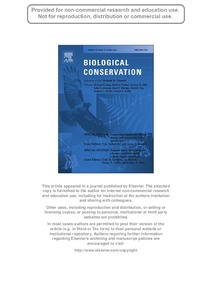| dc.contributor.author | Norris, K. |
| dc.contributor.author | Asase, A. |
| dc.contributor.author | Collen, B. |
| dc.contributor.author | Gockowski, J. |
| dc.contributor.author | Mason, J. |
| dc.contributor.author | Phalan, B. |
| dc.contributor.author | Wade, A. |
| dc.date.accessioned | 2019-12-04T11:13:59Z |
| dc.date.available | 2019-12-04T11:13:59Z |
| dc.date.issued | 2010 |
| dc.identifier.citation | Norris, K., Asase, A., Collen, B., Gockowksi, J., Mason, J., Phalan, B. & Wade, A. (2010). Biodiversity in a forest-agriculture mosaic–the changing face of West African rainforests. Biological Conservation, 143(10), 2341-2350. |
| dc.identifier.issn | 0006-3207 |
| dc.identifier.uri | https://hdl.handle.net/20.500.12478/2592 |
| dc.description.abstract | The biodiversity of West African rainforests is globally significant but poorly described, little understood in terms of its functional significance, and under threat from forest loss and degradation. Estimates suggest that about 10 million ha of forest may have been lost in the 20th Century, and around 80% of the original forest area is now an agriculture-forest mosaic. These highly modified forests provide food, fuel, fibre and a range of ecosystem services for over 200 million people. As a consequence, the future of biodiversity in the region is intimately linked with the lives and livelihoods of local people. The available evidence suggests that forest loss and degradation has been caused primarily by agricultural expansion, sometimes facilitated by other human activities such as wood extraction. This expansion is a response to the demand generated by a growing and increasingly urbanised human population, but has been exacerbated by small increases in crop yields over recent decades. We synthesize and review our state of knowledge on the value of human-modified habitats for forest biodiversity in the region. Data on biodiversity are patchy, but we show that across plant, invertebrate and vertebrate groups, there is a significant loss of forest species as tree cover is reduced and vegetation structure simplified. Agricultural expansion clearly causes significant local biodiversity loss. We argue that replicated landscape-scale studies are now needed that describe changes across a range of biodiversity groups (above and below ground) in relation to land-use and landscape context to address knowledge gaps and biases. Such descriptive studies need to be complemented by a deeper understanding of the causes of species turnover patterns, together with work on the consequences of biodiversity loss for ecosystem function and services. Biodiversity conservation in the region is becoming increasingly embedded within a more multi-functional view of agriculture-forest mosaics that attempts to recognise and value the range of services provided by tree cover and other land-uses. This relatively new perspective has the potential, at least in principle, to re-shape the drivers of land-use change because tree cover can generate additional revenue through carbon trading or certification schemes. It will become clearer over the coming decades whether this potential can be realised, but the implications for biodiversity conservation in the region are potentially profound. The socio-economic processes that have driven forest loss and degradation in West Africa are having an increasing impact on the relatively undisturbed rainforest of the Congo Basin. We conclude by pointing out that while West African forest landscapes are a potent reminder of what might happen in Central Africa in the near future, they also provide insights for developing policies and practice that might avoid comparable levels of forest loss and degradation. |
| dc.format.extent | 2341-2350 |
| dc.language.iso | en |
| dc.subject | Tropical Forest |
| dc.subject | Land-Use Change |
| dc.subject | Ecosystem Services |
| dc.subject | Multi-Functional Landscapes |
| dc.subject | Deforestation |
| dc.subject | Degradation |
| dc.title | Biodiversity in a forestagriculture mosaic: the changing face of west Africa rainforests |
| dc.type | Journal Article |
| dc.description.version | Peer Review |
| cg.contributor.affiliation | University of Reading |
| cg.contributor.affiliation | University of Ghana |
| cg.contributor.affiliation | Institute of Zoology, London |
| cg.contributor.affiliation | International Institute of Tropical Agriculture |
| cg.contributor.affiliation | Nature Conservation Research Centre, Ghana |
| cg.contributor.affiliation | University of Cambridge |
| cg.coverage.region | Africa |
| cg.coverage.region | West And Central Africa |
| cg.coverage.country | Guinea |
| cg.coverage.country | Sierra Leone |
| cg.coverage.country | Cameroon |
| cg.coverage.country | Liberia |
| cg.coverage.country | Cote D'Ivoire |
| cg.coverage.country | Ghana |
| cg.coverage.country | Togo |
| cg.coverage.country | Benin |
| cg.coverage.country | Nigeria |
| cg.isijournal | ISI Journal |
| cg.authorship.types | CGIAR and developing country institute |
| cg.iitasubject | Forestry |
| cg.iitasubject | Biodiversity |
| cg.iitasubject | Land Use |
| cg.iitasubject | Plant Ecology |
| cg.iitasubject | Natural Resource Management |
| cg.journal | Biological Conservation |
| cg.howpublished | Formally Published |
| cg.accessibilitystatus | Limited Access |
| local.dspaceid | 93396 |
| cg.targetaudience | Scientists |
| cg.identifier.doi | http://dx.doi.org/10.1016/j.biocon.2009.12.032 |

